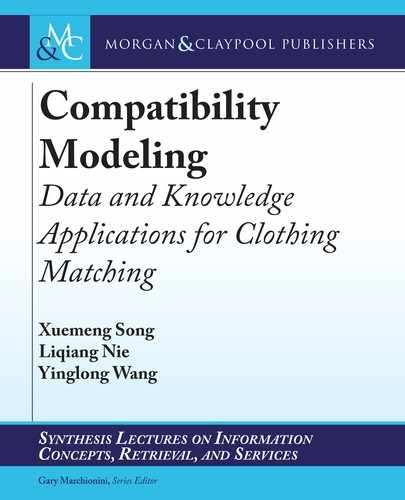
97
C H A P T E R 8
Research Frontiers
us far, in this book we have provided an in-depth introduction to compatibility modeling
problems, ranging from the data-driven compatibility modeling to the personalized capsule
wardrobe creation. To tackle these problems, we propose several general schemes for differ-
ent contexts. In particular, we first introduce the great demand for automatic clothing matching
scheme and identify the essential problem of compatibility modeling between fashion items.
en we analyze the prominent research challenges toward this end, such as the absence of
comprehensive benchmark, comprehensive modeling, knowledge incorporation, interpretabil-
ity, and subjective aesthetics. To address these issues, we present a series of compatibility model-
ing methods, comprising the data-driven compatibility learning, knowledge-guided compatibil-
ity modeling, prototype-wise interpretable compatibility modeling, personalized compatibility
modeling, and personalized capsule wardrobe creation framework. To evaluate these theoretical
methods, we create three real-world datasets collected from the online fashion communities,
Polyvore, Ssense, and IQON, respectively. We have released all the involved datasets, and codes
to the public
1
as illustrated in Figure 8.1.
In a sense, the theories on compatibility modeling presented in this book can benefit plenty
of stakeholders of fashion industry, such as the retailers, stylists, and end-users. For retailers,
especially the online ones, they usually employ professional fashion models wearing the fashion
items to promote the sales. With the help of compatibility modeling, retailers can learn how
to compose more eye-catching outfits and let models display for attracting the consumers to
purchase. In addition, knowing which fashion items are compatible, retailers can recommend
the related compatible complementary items for an item, like recommending a ripped light jeans
for a T-shirt, which is more likely to raise deals when people are browsing aimlessly. Regarding
the stylists, compatibility modeling can help them learn the popular compatible prototypes (i.e.,
attribute interactions) with the huge amount of real-word user generated data and then design
suitable outfits for ordinary people. Toward end-users—the main beneficiaries, they can learn
how to dress properly with the proposed automatic compatibility modeling technique without
consulting stylists at great expense, and make their wardrobes concise and compact, which also
undoubtedly saves both time and money expenses for end-users.
Although the above studies have shed some light on fashion compatibility modeling, we
have to admit that this research line is still at young and up-and-coming stage. Here we list a
few promising future research directions with their corresponding challenges.
1
https://ilearnfashion.wixsite.com/compatibility-model/
..................Content has been hidden....................
You can't read the all page of ebook, please click here login for view all page.
